
Pork Menu: 1 2 3 4 5 Next>>
Pork As Food During the Golden Age of Piracy, Page 3
Eating Pork: Bad and Spoiled Meat
While salted meat was the best contemporary defense against rotting, several period accounts reveal the dark side of salted pork. A few writers suggested the presence of salt itself were detrimental to the sailor's health. The biggest problems seems to have been that salted pork did go bad at sea... and was still served to the men.
The Downside of Salt
Captain William Funnell, in recounting the depletion of the supplies in a voyage in 1705 explained that when the other supplies ran out, "we went to our half pound of Flower a Man per day, and our two ounces of Salt Beef or Pork every other day. The Meat has been so long in Salt, that when we boiled it, it commonly shrunk one half. So we finding a loss in boiling our Meat, concluded to eat it raw; which we did all the Voyage after, so long as it lasted."1
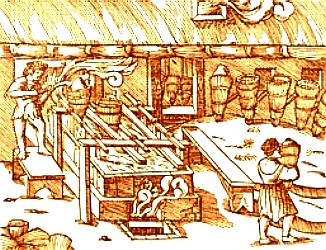
Artist: Georgius Agricola
Processing Brine - Evaporation Tank and
Draining
Baskets,
From De Re Metallica (1556)
Salting meat would tend to dry it out - removing the moisture and shrinking it somewhat. Cooking meat can also shrink it quite a bit - up to 40% of the water can be lost in a fresh cut of meat, depending on the fat content - especially if it is cooked at to high a temperature (more than 135 degrees) and for too long a period.2 However, the fact that the meat had been in salt for a greater or lesser period of time probably didn't contribute much to shrinkage during cooking. Still, this does highlight a concern about salting of the meat on behalf of a period sailor.
Seventeenth century sea surgeon John Woodall theorized that salt-meat contributed to scurvy. "The cheefe cause [of scurvy] is the continuance of the salt diet, either fish or fresh, as porke and the like, which is not [able] to be avoided at sea, as I suppose by the wit of man"3. This is not true either. Not wanting to miss the real cause of scurvy, Woodall lists a great many possible causes, including the true one: lack of vitamin-C rich fruits and vegetables. However, it again points to concern about salt pork in the diet.
In a similar fashion, Edward Barlow points to salt meats as a villain. He explains that one ship's "men [were] very sickly through means of their bad provisions, having no bread but eating all rice and their salt beef and pork, very old and stinking, and having no other drink but water, drinking much water, and the rice being of a waterish nature, bred a kind of dropsical disease [probably beriberi - a vitamin B deficiency disease, the symptoms of which are similar in many ways to scurvy], which swelled them up with water, and in a short time killed many of their men in their ships."4 Salt is again innocent of the charges, but the concern is notable.
1 William Funnell, A Voyage Round the World, p. 226; 2 Mythbusting Resting Meat, AmazingRibs.com, gathered 4/10/14; 3 John Woodall, the surgions mate, p. 179; 4 Edward Barlow, Barlow’s Journal of his Life at Sea in King’s Ships, East and West Indiamen & Other Merchantman From 1659 to 1703, p. 242Rotting Salt Pork
"Pork was potentially a more dangerous product than beef; it deteriorated more quickly, and carried a greater number of communicable diseases." (Emily Cockayne, Hubbub: Filth, Noise, and Stench in England, 1600-1770, p. 95)
Although salting would likely kill many of the vermin and their accompanying diseases1, there were still multiple contemporary examples of rotting salt pork at sea. Chief among these are the comments of inveterate 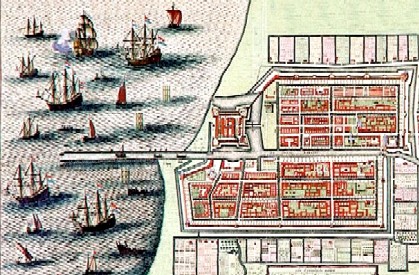
Artist: Clement de Jonghe
Batavia, Indonesia - HQ for the Dutch East India Company (1740)
whiner Edward Barlow. He complains in 1661 that the men were "eating always salt beef and pork, which many times has lain in salt one year or two"2. In 1672 he comments that he and other men sick with fluxes had "no other thing to eat and drink, to restore health, and comfort ourselves with, unless we can eat a piece of hard biscuit cake, or a piece of old salt beef or pork, and maybe both stinking and rotten, having lain in pickle one year or two"3. In 1674, he explained that the Dutch claimed to have provisions stored at Batavia (Jakarta, Indonesia), but that it was "only in salt beef and pork, which they send from Holland, which lieth in salt so long till it be half rotten and stinking like carrion, and they make their poor seamen to eat"4.
Still, Barlow seems to have a point. Writing in the early part of the 18th century, surgeon Patrick Campbell reported that on the hospital ships where he served "the pork was overcooked to conceal the putrefaction."5 After feasting in Tres Marias in 1709, the stalwart Woodes Rogers opined, "I wish 'twould hold, but 'tis in vain to tantalize our selves; for we must soon fare [eat] otherwise, and take to our old Food of almost decay'd Salt Pork and Beef, which we must prize, and heartily wish we had more on't."6
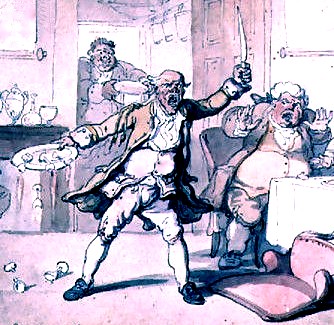
Artist: Thomas Rowlandson via Wiki Gallery
Madness at the Dinner Table (1816)
The problem of pork rotting on long voyages in hot climates led Samuel Pepys to order "that ships bound south of latitude 39° N. should have an allowance of flour, raisins or currants instead of beef and pork... this replacement of products which soon became rancid in hot climates by ones which remained fresh was inspired by both Dutch and Spanish practice."7 However, these and other, similar climate-appropriate changes were "reluctantly accepted in official circles and aroused open opposition among the men."8
Military surgeon William Clowes told of 'two seafaring men' whom he felt had gotten scurvy because of their diet. Unlike Woodall, he didn't blame the salt in the meat, but reported the he 'gathered by enquiry' that the disease "was reputed principally unto their rotten and unwholesome victuals, for they said their bread was musty and mouldy biscuit, their beer sharp and sour like vinegar, their water corrupt and stinking.... Their beef and pork was likewise, by reason of the corruption thereof, of a most loathsome and filthy taste and savour, insomuch that they were constrained to stop their noses when they did eat and drink thereof."9
1 Thanks to Jim McGavin for pointing this out, See Pork during the GAoP, April 2, 2014, Pyracy.com Forums, gathered 4/11/14; 2 Edward Barlow, Barlow’s Journal of his Life at Sea in King’s Ships, East and West Indiamen & Other Merchantman From 1659 to 1703, p. 242; 3 Barlow, p. 214; 4 Barlow, p. 236; 5 Patrick Campbell, cited in Zachary B. Friedenberg, Medicine Under Sail, p. 30; 6 Woodes Rogers, A Cruising Voyage Round the World, p. 150; 7,8 John J. Keevil, Medicine and the Navy 1200-1900: Volume II – 1640-1714, p. 91; 9 William Clowes, Selected Writings of William Clowes, p. 119 ;
Eating Pork: Unhealthy?
"The Indians went all to the vessel, taking forth whatever they could lay hold on, except rum, sugar molasses, beef and pork." (Jonathan Dickinson, Jonathan Dickinson's Journal or God's Protecting Providence, p. 7)
Like the Indians rifling Dickinson's wrecked craft in Florida, some authors felt that it was best not to include pork in one's diet. Thomas Tryon noted that people who frequently ate pork, had "dull and heavy Spirits; therefore such People are not so brisk and airy, but duller of Apprehension than others that eat more airy and thinner food".1 He admitted that "the Flesh of Swine is of great use, but not wholsom to be eaten fresh... this Flesh, where it is frequently eaten, does generate a gross Nourishment; 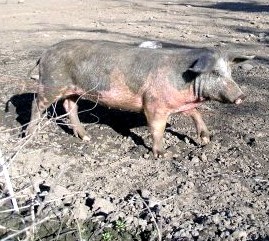
Photo: Hywel Williams
A Free Roaming Pig Going About His Business
but the way that English People use for ordering it, makes it much better than otherwise it would be."2 Tryon explained that salting and smoking pork would give it a "brisk lively Red Colour, which does much correct that gross Quality that is contain'd in [the pig's] Flesh"3.
Although some authors writing on healthy food at this time regarded pork with a jaundiced eye, they generally believed that pigs which were free to roam and fed on healthy foods produced pork that was more amenable to the human body. Tryon admitted that "altho' Swine naturally are the uncleanest of all Creatures that are so much eaten, nevertheless if they be fed with Corn, and are sing'd and kill'd in the properest Season [fall] then well Salted, and rusted [smoked?] a considerable time, they are made thereby a firmer and wholsomer food than several other sorts of clean Flesh" which was eaten fresh-killed.4 Andrew Weir says "it was believed to be healthy if the pig had been allowed to roam in the wild and eat natural foodstuffs."5 Ware goes on to give several contemporary examples of this.
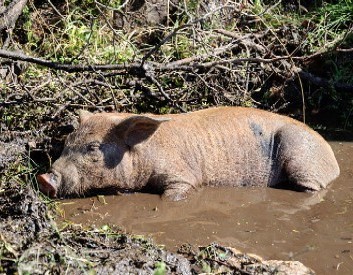
Photo: Wiki User Myrabella
A Pig Cooling Itself in the Mud
Thomas Fuller in his History of the Worthies of England (1662), praises 'Hampshire Hoggs' as producing the best bacon [meat] because 'Here the swine feed in the Forrest on plenty of Acorns (mens meat in the Golden, Hog's food in this Iron Age); which going out lean, return home fat, without either care of cost of their owners... they lodge at liberty (not pent up, as in other places to stacks of Pease [peas]), which some assign the reason of the fineness of their flesh.' Thomas Mouffet [writing in 1655] agreed that the pig was especially nourishing 'if he feed abroad upon sweet grass, good mast and roots; for that which is penn'd up and fed at home with taps droppings, kitchin offal, soure grains and all manner of drosse cannot be wholsom'.6
Surgeon John Wilkinson, writing in 1764 about the health and well-being of men at sea advised that, "The less pork is eaten, the better; it ought to be prohibited in hot climates and seasons, or else to be eaten with good plenty of vinegar."7 Wilkinson went on to explain that "pork retards perspiration. the hog is remarkable for filthiness, and feeding upon all kinds of ordure [excrement], even carrion [decaying flesh] if it lied in his way: it is the only animal in the brute creation, subject to scrofulous diseases [tuberculosis] and the leprosy"8.
Of course, these were minority opinions. Pork had been a part of the seaman's diet long before these comments were made and has continued to be so to this day.
1 Thomas Tryon, The Way to Health, Long Life and Happiness, p. 68; 2,3,4 Tryon, p. 67; 5 Andrew Ware, Knowledge and Practice in English Medicine, 1550-1680, p. 206; 6 Ware, p. 206-7; 7 John Wilkinson, Tutamen Nauticum or The Seaman's Prevention from Shipwreck, Diseases and Other Calamities Incident to Mariners, p. 79; 8 Wilkinson, p. 79-80
Pork on Ships
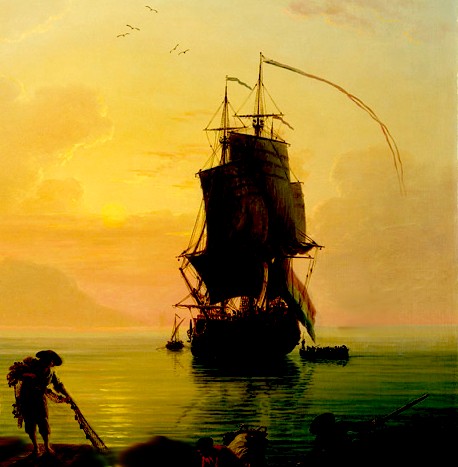
Artist: Claude-Joseph Vernet
A Ship in Port, Gathering Supplies (1770)
Quite a bit of pork found on naval and merchant ships was salt pork. As has already been shown, this had a limited shelf life, particularly in the heat of the Caribbean and coasts of Africa where much of the golden age of pirate activity took place. For the pirates there was the additional problem of not having access to normal channels of food distribution, making it a bit more difficult for them to obtain salted pork in casks. Their most likely way of obtaining such pork was to remove the barrels from captured vessels when food was needed.
Ships sometimes kept live animals on board to provide fresh pork, although this presented problems with having to feed the livestock and clean up after them. Ships stopping to refresh their supplies or repair their ship could also purchase pork at local ports or hunt for wild hogs where they were available. Pirates actually had an advantage that ships on legitimate missions did not; pirates could make landfall whenever they chose, provided it was safe for them to do so. (Not all ports were pirate friendly.) So, all things being equal, they would usually have had readier access to fresh pork.
Pork on Ships: Keeping Livestock Shipboard
"In the mean time [Pirate Captain Charles] Vane made towards the coast of Hispaniola, living riotously on board, having an abundance of liquor, and plenty of fresh provisions, such as hogs, goats, sheep, and fowl, which he got upon easy terms; for touching at a place called Isleathera, he plundered the inhabitants of as much of their provision as they could carry away." (Captain Charles Johnson, The History of the Pirates, p. 223)
There are only a handful of period and near-period references to keeping livestock on a ship. Nearly all of these are mentioned only because something happened that affected the livestock. This hints that livestock on a vessel might have been so normal that it didn't merit mention otherwise.
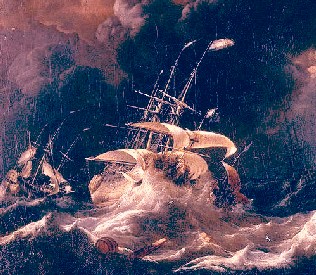
Artist: Ludolf Bakhuisen
Dutch Merchant Ships in a Storm
(late-17th c.)
A prime example of this comes from Edward Barlow, who noted in a 1699 entry. His ship drove 'to and fro', causing "much damage and loss in our fresh provisions, having 'drownded' a hundred fowls, hens, cocks, turkeys and geese, and several pigs and hogs, and some sheep, and bruising much the live bullocks we had aboard, spoiling their flesh very much."1
Jonathan Dickinson likewise revealed that as a result of 'the violence of the weather' the "hogs and sheep were washed away and swam on shore, except one of the hogs which remained in the vessel."2
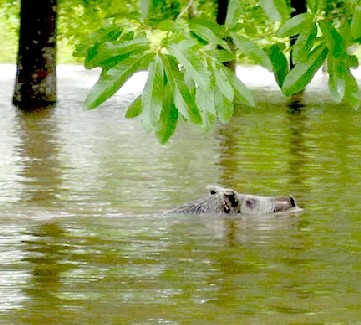
Artist: Fish and Wildlife Service, SE Region
A Hog Swimming For Shore
Our two clergy gourmands also mentioned that their ships carried live swine while commenting on other matters. Père Labat explained how in Cadiz, the locals were trying to sell them fresh provisions, only to find "our pens of full of chickens, pigs, sheep and goats that there was sufficient live stock on board for a return voyage to America."3 Not one to miss an opportunity for good food, Labat noted that they "bought their peaches, apples and pears, and more especially their very fine grapes"4.
While in Spain, Chaplain Henry Teonge explained that the ship's captain "bought three Spanish hogs: the roughness of the weather made them so sea-sick that no man could forbear laughing to see them go reeling and spewing about the decks."5 Funny, perhaps, to everyone but the man in charge of cleaning up (and the hogs).
1 Edward Barlow, Barlow’s Journal of his Life at Sea in King’s Ships, East and West Indiamen & Other Merchantman From 1659 to 1703, p. 508; 2 Jonathan Dickinson, Jonathan Dickinson's Journal or God's Protecting Providence, p. 47; 3,4 Pere Jean-Baptiste Labat, The Memoirs of Pére Labat 1693-1705, p. 262; 5 Henry Teonge, The Diary of Henry Teonge, Chaplain on Board H.M.’s Ships Assistance, Bristol, and Royal Oak, 1675-1679, p. 233

